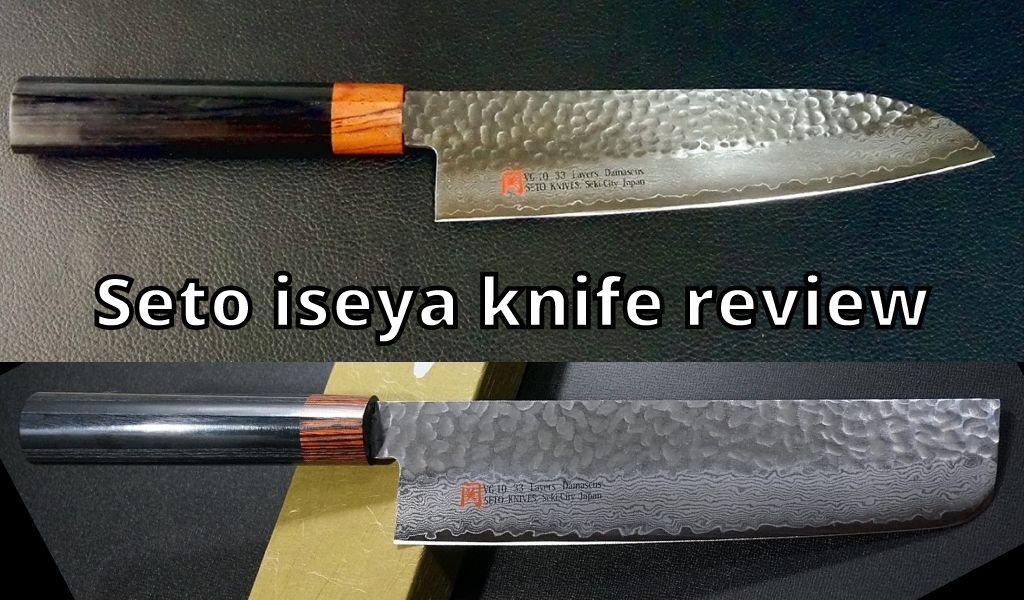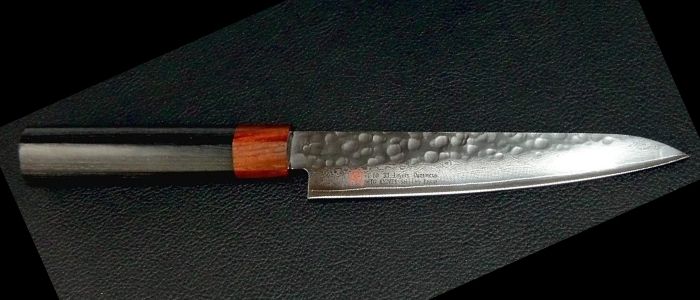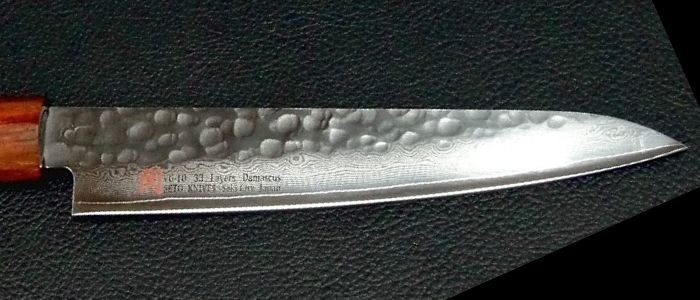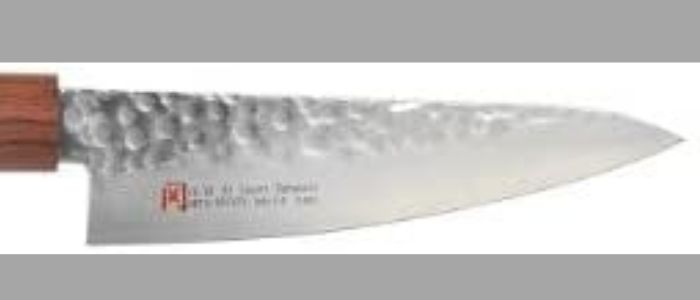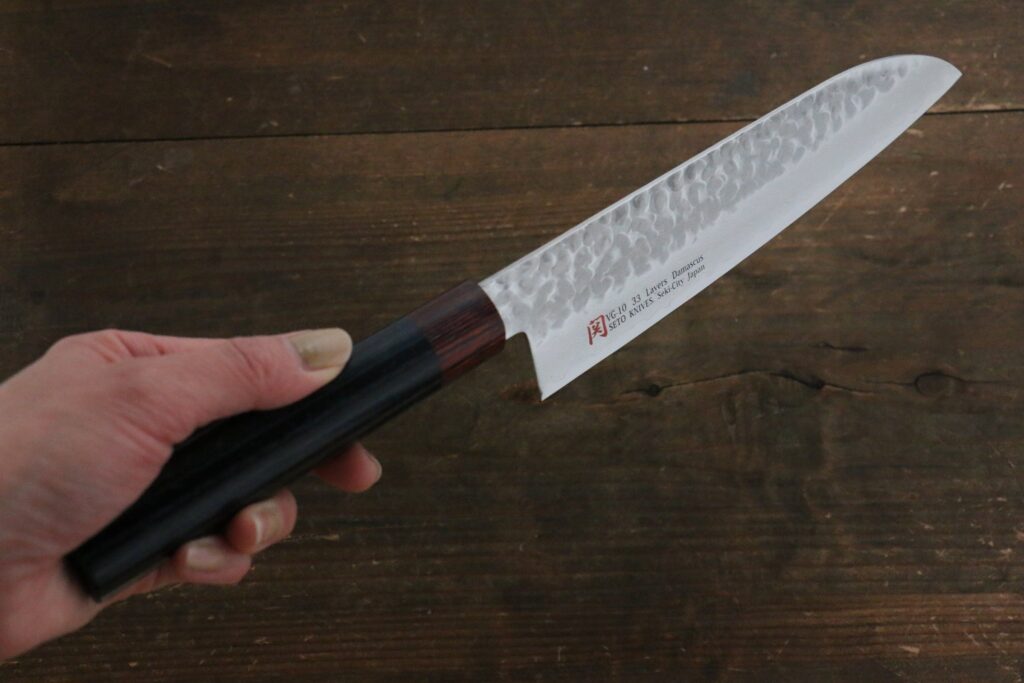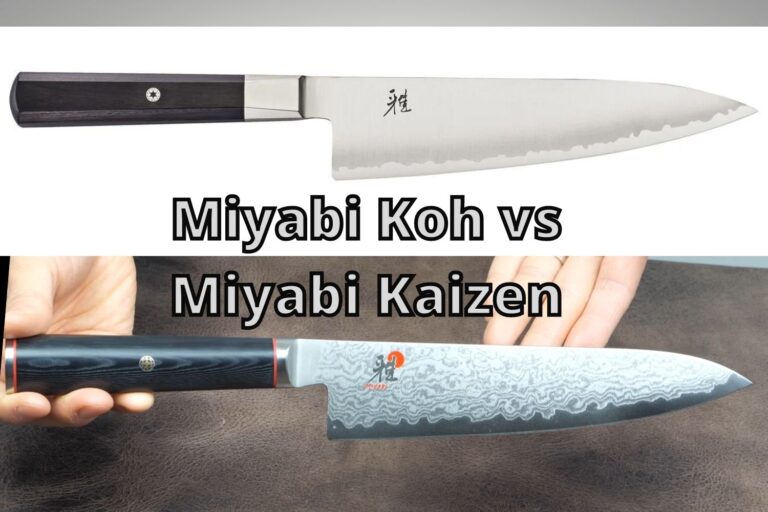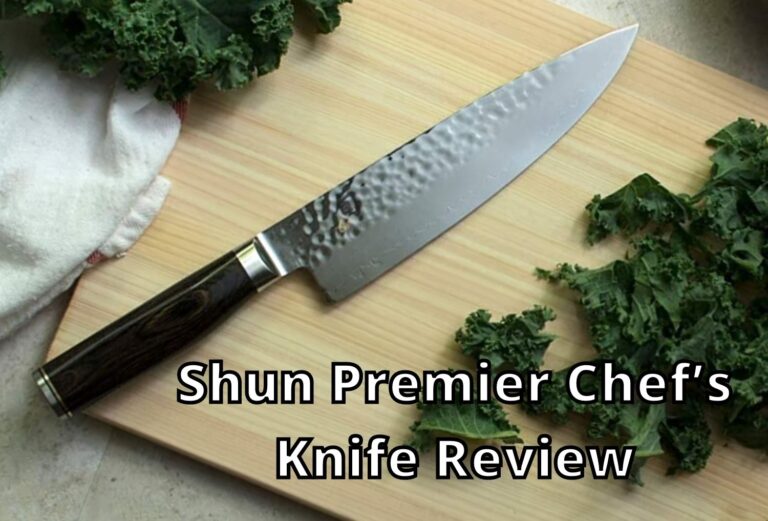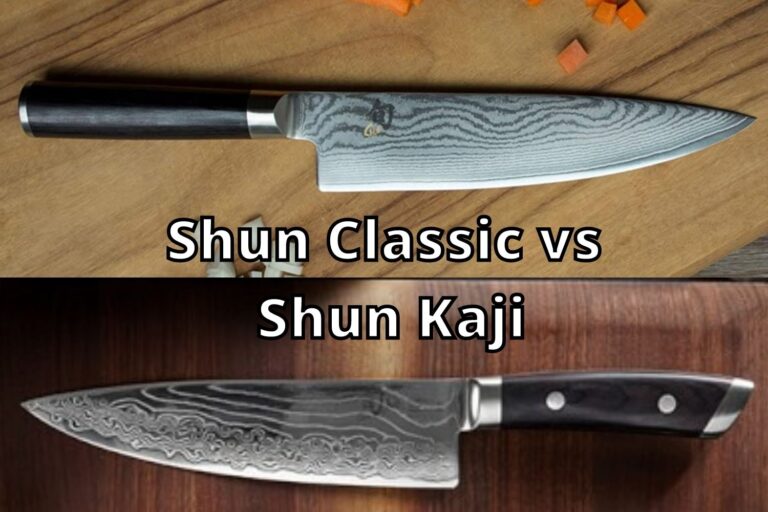While looking for a quality chef knife for your kitchen you may have come across seto knives. Do you want to know more about seto knives? Actually, seto knives are the result of the dreams and desires of a master Japanese sword maker, Yoshi Seto. He had a dream to make the greatest living blades of japan. His company is still carrying his tradition and dream to make the best knives and swords possible. That’s why each knife of seto still carries historical beauty and elegance.
Let’s go through this detailed Seto knives review to know more about Seto chef knives. And let’s dive deep into every specific feature, pros, con, and customer thought about these knives.
Quick Overview: Seto iseya knife review
If you are in hurry then before going through this whole seto iseya i series review, you can go through this quick overview about Seto knives.
- The knife is handcrafted in Seki, Japan.
- The blade core of the knife is made with VG-10 super stainless steel.
- There is a total of 33 layers of stainless steel and layers around the core protect the core.
- There are 3 layers of design on each knife. The upper half portion is hammered finished, then there is a gorgeous Damascus pattern and the portion near the edge has a plain mirror finish.
- Each knife of series is made from forged steel.
- On the Rockwell scale, these knives have 60 hardness.
- The handle is made with Red Sandalwood.
- It features a traditional Japanese D-shaped handle.
- All of these knives are full tang knives.
- There are 4 types of knives in this series. Those are Santoku knife, Nakiri knife, Petty knife, and paring knife.
Seto Knives Review (Seto iseya i series review)
Where they are made
Seto knives carry a long history in japan. These beautiful knives are being handcrafted in Seki, Japan for years. As mentioned at the beginning of this seto Iseya vg10 review, seto knives were the dream of a master sword maker Yoshi Seto. To make his dream true and make the greatest living blades he trained himself with the top sword-making skills of his days. Though he is not alive now his company is still carrying the tradition and crafting the best sword and knife possible. Still, each Seto’s Japanese chef’s knife carry the elegance and beauty of a traditional Japanese knife.
Knives of this series
In this Seto Japanese chef knife series, there are four types of knives. Rather than their shape and size, these four knives have exactly the same blade building material, handle material, hardness, sharpness, and durability. Even their blade construction and finish are the same. These four knives of seto iseya knife series are:
1. Seto Santoku Chef Knife
2. Seto Nakiri Knife
3. Seto Petty Chef Knife
4. Seto paring Knife
Blade Material
Blade material is the backbone of a knife. Almost all qualities of knife-like hardness, durability, edge retention depend on the steel that is used for a knife.
The blade core of the Seto iseya knife is made with VG-10 stainless steel. This VG-10 super steel is known as the gold standard steel of knife making.
VG-10 core remains wrapped by other 16 layers of stainless steel on each side. So, with the core, there is a total of 33 layers of steel. These layers of steel protect the core against any kind of extra pressure. They also protect the core against rust, pitting, and damage.
The core VG-10 steel is famous among Japanese knife makers because of its qualities like hardness, edge retention, rust-resistant, etc. It is a high-carbon steel alloy of carbon, molybdenum, chromium, and vanadium. Carbon components contribute to increasing the hardness of the blade whereas chromium makes the knife rust-resistant. Other components make the knife more strong, durable, and flexible.
Blade Design
Seto knives blade features a design that is a combination of hammered finish, Damascus pattern, and plain mirror finish.
In the top half portion, the blade has a hammered finish, then the middle half portion has a gorgeous Damascus pattern. Total 33 layers of stainless steel create this beautiful Damascus pattern. And the portion near the edge has a plain mirror finish.
The hammered finish on the blade makes the knife nonsticky. This hammered finish creates a small air pocket on the blade and these air pockets prevent the sticking of food while using. Though all four knives of this Seto knife set have the same design they have a different shapes.
Santoku Chef Knife
This knife has a traditional shape as Japanese santoku knives. The top portion has more curves than the bottom edge part.
Nakiri Knife
Nakiri knives do not have any sharp tips. Moreover, it has a wide blade from one end to another.
Petty Knife
Petty knives are smaller versions of the average chef’s knife. It has a more slim and smaller shape.
Paring Knife
Unlike the Santoku chef knife in paring knife, the curve is at the bottom edge portion of the knife and the top portion is almost straight.
Hardness
The durability and edge retention of any knife depends on the hardness of the blade. And the hardness depends on the blade material and crafting process.
Seto iseya knife features both of these qualities. Firstly, As balde material high carbon VG-10 is used in this knife. Secondly, each knife is hand forged from a single steel block that means each knife is a forged knife. With these qualities, Seto knives Seki city has 60 Rockwell hardness. This hardness develops different qualities like long-lasting edge retention and longevity to a knife.
Handle material
As handle material, Red Sandalwood is used in each of these Seto knife set. Sandalwood is not any natural wood it is mainly a plywood-based material. This material helps to give the handle different color and look. Moreover, this material makes the handle comfortable to hold and provides a slipless grip.
Handle Design
Seto chef knife features a traditional Japanese D-shaped handle. This shape of the handle is being used by Japanese knives makers for centuries.
The whole handle has a black color with a brown wooden-looking portion near the balde and handles the connection. Because the handle features a black slip Monaca that makes the knife very comfortable.
The D shape handle fits nicely in the grip of the hand and provides fatigue-free work for a long. Moreover, there is no curve at any side of the handle. So, the handle is comfortable for both left and right-handed users.
Sharpness and edge
Each knife of the Seto iseya i series is hand-honed to a razor-sharp cutting angle. Expert Japanese craft smiths sharpened each knife following the traditional sword sharping process. They can cut through any food very precisely as like Japanese sword used to cut. As each of the knives is precisely shaped so you won’t need to create any pressure while cutting food.
Another thing is that each knife is double beveled. That means each knife of Seto knives vg10 has the same cutting angle on each side of the knife. So, all of these knives can be used by both hands.
Size
When it comes to the size the nakiri and Santoku knives have the same size. Both of them are 180mm long. And the paring knife is the shortest one, it’s only 135 mm long that can be used for small tasks. Finally, the petty knife has an average size between the santoku and paring knife. It is 150mm in size.
Tang
As mentioned before in this Seto iseya knife review, all four knives of this iseya vg10 33 layer series are full tang knives. In full tang knives, a part of the blade goes all the way through the handle. Full tang knives are always preferred over half tang knives. Because full-tang knives are more durable and provide better balance while working.
Weight and balance
Though all of the Seto chef knives are forged knives they are super lightweight. Each knife has an average of 1.76 ounces of weight that you will hardly find in any knife. Moreover, the blade material, handle material, tang all these things contribute to the proper weight distribution to the knife. That adds proper balancing while using. So, with these qualities, each knife can provide fatigue-free work for a long time as mentioned in this iseya i series review.
Clean and maintenance
Proper care and maintenance is the thing that can carry a low-quality knife for a long. Whereas without proper caring and maintenance even very high-end knives may get rust or get damaged.
Though it is not said by the manufacturer that these knives are not dishwasher safe. But it is always preferred to handwash these knives. After light use, you can just wash this knife with clean water and after heavy use, you can use soap and cloth.
After washing it is better to dry the knife properly. Just put the knife in an open place so that water dries out.
Never put the knife in a drawer without any sheath or protector because that may cause damage. Even the sharp edge of Seto knife japan can cause harm to you. So, you can use an extra sheath or knife block to store your seto kitchen knife.
How the knife will feel in your hand
A knife may have quality material, gorgeous design but the thing that most, at last, is the feel of the knife in hand.
As the knife has a rounded D-shaped handle it fits nicely in your hand. And you will get a comfortable grip. As the knife has no curve at any particular side it is comfortable for both right and left-handed users.
These Seto iseya i series knives are extremely lightweight as mentioned before in this iseya vg10 33 layer Damascus review. So, it provides a perfect balance, and even after long use, it doesn’t create pain on the wrist. Moreover, the sharp edge of these knives can go through any food smoothly. So, you won’t need to create pressure on food while using these iseya vg10 33 layer Damascus knives.
Customer’s thought
Most of the reviews about seto iseya vg10 knives are positive and you will hardly find any negative feedback.
One negative review was that one user was not happy as these knives are too lightweight. As he is a sushi chef he needs a knife with average weight. Another user mentioned about customer service. He didn’t like the customer service provided by the seto company.
Rather than these few negative reviews, most other reviews are positive reviews. Users have told about different features like incredibly constructed knives, high-quality steel. One user mentioned the gorgeous Damascus design as we have known in this Seto Iseya molybdenum steel review. One mom described her experience of how he gifted this knife to her son and her son loved this knife so much.
Pros
We have already gone through the features and pros of these knives through this whole Seto chef knife review. let’s gather them here briefly.
- Razor-sharp edges provide precise and effortless cutting.
- The hard blade of seto knife retains its edge for a long.
- Food doesn’t stick to the knife while cutting.
- Each of the knives is super lightweight.
- These seto knives are very easy to use.
- A D-shaped handle is comfortable for both hand users.
- One amazing thing is that when the handle gets wet it retains the grip even better than when dry.
- The knife features proper balancing.
- There are four knives that you can have according to your purpose
Cons
You may already know the drawback of this knife from this Seto iseya knife review. These are:
- These knives don’t come with any sheath.
- Heavy knife users may not feel comfortable with these super lightweight knives.
- Needs to be handled with extra care as the edge is extremely sharp.
FAQ
- Are these Seto knives double edge or single edge?
All of the seto knives are double edge or double-beveled knives. As mentioned before in this seto iseya vg10 33 layer Damascus review set chef knives to have the same cutting angle at both sides of the knife.
- Is the Seto iseya knife made in Japan?
Yes, All of the seto iseya knives are crafted in Seki, Japan. Expert bladesmiths handcrafts every piece of a knife following traditional Japanese knife-making techniques.
- Do these knives come with a sheath?
As said in this seto iseya review, seto chef knives don’t come with any sheath or cover. So, it is better to use an extra sheath or a knife block to store the knife.
- These are carbon steel knives?
Direct carbon steel is not used in seto knives. Instead of that VG-10 super stainless steel is used for these knives. There is a high amount of carbon component in VG-10 steel that makes the knife hard like carbon steel.
Conclusion
A knife-like seto is essentially the workhorse of the kitchen. You can really feel and see that someone has put his heart and soul into every piece of the knife. And I hope you have got a clear idea about seto chef knives from this Seto knives review.
So, if you want a high-end knife at an affordable price then these seto iseya knives are great knives to go. We have talked about four knives of the same seto iseya i series in this seto iseya i series review. If you want a knife to handle a wide range of work in your kitchen you can have the santoku one. Paring or the petty knife is best for small work and the nakiri knife is for vegetable and normal food cutting.
Other Knives Review:

